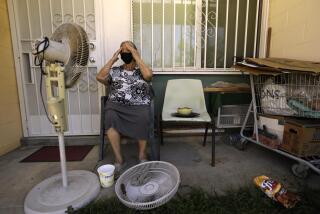Keep Air Conditioner Cool With Regular Maintenance
- Share via
Many homeowners instinctively feel that fixed appliances (furnaces, central air conditioners and water heaters) are simply too permanent and complex to be included in a routine maintenance schedule. This is a costly position.
An investment of an hour or two will not only extend the lives of these appliances but also save plenty in operating costs.
Of the three major appliances, central air conditioners probably suffer most from poor maintenance.
The problem is dust. In less than a season, the compressor fin tubes can become completely clogged with dust.
Because a large volume of air must be drawn through these fins with every cooling cycle, a matting of dust will stress the fan and compressor motors and greatly reduce efficiency. When years of accumulation go unchecked, the problem grows large.
To correct the problem, clean the inside of your compressor unit each spring. A midsummer cleaning also is a good idea.
When cleaning compressor units, begin by shutting off the power. This usually can be done at the dedicated disconnect switch near the unit. Remove the front access panel to reveal the compressor and the electrical and refrigeration connections.
You’ll then be able to undo the top panel that supports the fan and fan motor. Because the top panel is largely open, shielded only by a coarse screen, leaves and other debris are likely to have fallen into the unit. Carefully lift the fan and clean out the debris.
With the area inside the condenser coil cleared, remove the shroud from around the coil. This will reveal the exterior of the coil, where the fin tubes support the accumulation of dust.
Use a soft-bristle brush to sweep away the dust blanket. Don’t press too hard or you’ll bend the edges of the fin tubes, which will also reduce efficiency. When all of the dust has been swept from the coil, vacuum it up so it will not be pulled back into the coils when the unit starts up.
Next, check for oil ports at the top of the compressor. If you see any, lubricate them with all-purpose oil or turbine oil. If you find no oil ports, the compressor is sealed and no oil will be needed. With the compressor unit cleaned, replace the side and front panels and restore electrical power.
Along with the outdoor condenser unit, your air conditioner will have an indoor evaporator coil, usually within the furnace plenum.
In most cases, you’ll have no direct access to this coil, short of cutting through the plenum. If you find an access panel, clean the coil with water and bleach. The goal is to remove any accumulation of bacteria that may have collected at the base of the coil.
Finally, keep an eye on the condensate hose attached to the evaporator coil. This tube, which typically runs from the evaporator coil atop the furnace to the nearest floor drain, often can become clogged. The result is water spilling into the furnace or onto the floor.
Your best preventive measure is to pour a 50/50 mix of water and household bleach through the hose midway through each cooling season.
